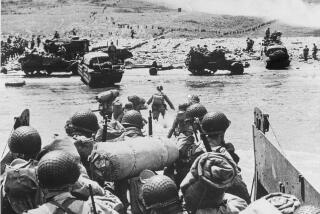Calamity of Exercise Tiger Overshadowed by D-Day : World War II: It began as a dress rehearsal and ended in tragedy as German torpedo boats stumbled onto eight landing ships. Two were sunk, a third was damaged, 749 U.S. soldiers and sailors were killed.
- Share via
Exercise Tiger began innocuously as a dress rehearsal for D-Day; it ended in cataclysm, with 749 U.S. soldiers and sailors dead in the English Channel.
But the next day--and for the many days after that--no word of the disaster appeared in American newspapers. It had to be hushed up, lest the Germans know the Normandy invasion was imminent.
Fifty years later, the April 28, 1944, catastrophe is still shrouded in D-Day’s shadows, much to the anguish of the men who survived it and the families of those who didn’t.
“People should know the story. These men should be recognized,” said Evelyn Brannock of Perry, Kan., whose brother, James Oliver Cottrell, was among the dead.
“There isn’t anything about it in the history books. Nothing. Zero. It’s kind of sad.”
Exercise Tiger was the U.S. 4th Infantry Division’s final tuneup for D-Day, which took place in June. Tiger involved 3,000 ships and 30,000 men outfitted in full battle dress.
The men and ships sailed into the channel to practice a landing at Slapton Sands. But the drill became a death trap when a pack of nine German torpedo boats operating from France stumbled onto the eight LSTs (landing ship, tanks) of Convoy T-4 shortly after 2 a.m.
The German speedboats, traveling at 40 m.p.h., darted around the lumbering LSTs, chugging along at 5 m.p.h. Two LSTs were sunk and a third was damaged in 30 minutes.
On LST 507, Navy medical officer Eugene Eckstam heard a deafening explosion and rushed to help trapped men.
“I got thrown back by the roar of the fire. I could hear guys screaming and hollering. I can still hear them,” said Eckstam of Monroe, Wis.
LST 531, hit next, went under in seven minutes, losing 424 of the 496 men on board.
“Bang! There was an explosion. Just a big ball of fire,” said John Perry, of Johnstown, Pa. “The Germans just picked us off. We were sitting ducks. We never knew what hit us.”
LST 289 was also torpedoed. The final toll--551 soldiers and 198 sailors dead, and 89 participants wounded--made Exercise Tiger the war’s most deadly U.S. training exercise.
Some Allied lapses worsened the tragedy, according to investigations.
The convoy was guarded by only one British ship. Additionally, because of a typographical error on operational orders, the American ships were tuned to the wrong radio frequency, so British warnings of German boats never reached them.
And GIs improperly buckled their flotation belts around their waists rather than up under their shoulders. Top-heavy with field packs, rifles, ammunition and steel helmets when they splashed into the 42-degree waters, many were found floating feet up.
Among those who handled the corpses was Emmett Bailey, a member of a graves registration unit.
“I didn’t shed a tear at the time because it was my job. Now I can hardly keep my eyes dry when I think about it,” said Bailey, of Henderson, N.C. “Things like that stick with you.”
British newspapers published brief stories repeating German radio reports about some shipping being lost. The first official mention came at an Aug. 5 briefing when Exercise Tiger’s casualties were included in post D-Day reports.
One final casualty came that same day. Rear Admiral Don P. Moon, in charge of the American part of the exercise, killed himself on his new assignment in the Mediterranean, due at least in part to admonishment from his superiors for the losses at Slapton Sands.
Years after the war, accounts of Exercise Tiger appeared in some military history books, but the Pentagon did not declassify its records until 1974. Ten more years passed before the secrets of Exercise Tiger were published, when Dr. Ralph Greene of Chicago, a medical officer who treated some of the survivors, wrote about it in American Heritage magazine.
In 1987, a granite memorial placed near a Sherman tank recovered from the channel was dedicated at Slapton Sands. Two years later, VFW Post 1531 of New Bedford, Mass., dedicated a monument there that includes a Sherman tank and a cobblestone for each casualty.
“Some type of acknowledgment should be made of their service and the lives they gave for their country,” said Ed Gilchrest, president of the Exercise Tiger Memorial Assn. in New Bedford. “These were the forgotten dead.”
More to Read
Sign up for Essential California
The most important California stories and recommendations in your inbox every morning.
You may occasionally receive promotional content from the Los Angeles Times.













